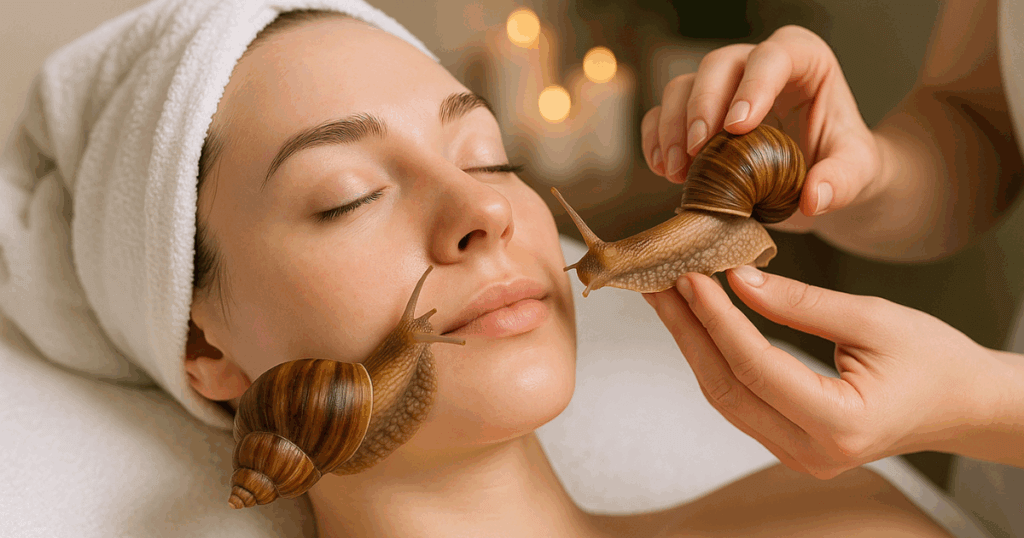The first thing that comes to mind when you mention the word ‘snail facial’, is that moment in The Lion King when Simba has tasted some grubs for the first time and gives his memorable verdict: “Slimy, yet satisfying”.
Slime is a big part of snail facials. There’s no getting around that. However, ‘satisfying’ is also a part of the equation. Many people are willing to endure this unconventional facial treatment because while it is slimy, it is also satisfying. Simply, it does its job in satisfying the skin with its hydrating, anti-ageing and skin repair properties.
An Age-Old Beauty Practice
The procedure involves placing live snails directly onto the face and then allowing them to glide across the skin. As they do this, they leave behind a trail of nutrient-rich mucus.
As unusual as this all sounds, it is rooted in ancient remedies. The origins of using snail secretion in skincare can be traced back to ancient Greece, where Hippocrates reportedly recommended crushed snails and sour milk to treat inflammation.
However, the modern iteration of the snail facial first gained traction in East Asia, particularly in South Korea and Japan, countries renowned for their innovation in skincare and beauty treatments. Snail mucin became a key ingredient in Korean beauty products in the early 2000s, and live snail facials began appearing in high-end spas shortly thereafter.
The treatment caught the attention of international media in 2013 when a Tokyo-based salon called Ci:z.Labo introduced a live snail facial as part of its luxury spa menu. Photos of people lying calmly while snails crawled over their faces went viral, capturing global curiosity and generating discussions about the future of bio-beauty.
Not For The Faint-Hearted
The snail facial is exactly what its name suggests and it is definitely not for the faint-hearted! Live snails are placed on the client’s face during a spa treatment. A specific breed called Cryptomphalus aspersa is used. These snails are known for their gentle temperament and beneficial secretion.
As the snails slowly move across the skin, they secrete a slimy trail rich in ingredients, including hyaluronic acid, glycoprotein enzymes, antimicrobial peptides, and antioxidants. These compounds are believed to help hydrate the skin, stimulate collagen production, reduce inflammation, and improve the appearance of scars and fine lines.
The process usually begins with a thorough cleansing of the face. Once the skin is prepared, the snails are carefully placed on the cheeks and forehead and allowed to move freely for several minutes. Afterward, the remaining mucus is gently massaged into the skin, followed by the application of additional serums or moisturisers to lock in the benefit of the mucus.
Some versions of the treatment use snail mucus-based products rather than live snails for a less intense alternative.
The Slippery Path To Beauty

Reactions to the snail facial are as varied. Some people are enchanted by the novelty and claim remarkable results. Others are more cautious about the idea of live animals as part of their beauty regime.
In an interview with The Telegraph, British beauty journalist Alice Hart-Davis described her snail facial experience in Tokyo as ‘soothing and oddly relaxing’, noting that the sensation was ‘cool and slightly ticklish but not unpleasant.’ She added that her skin felt ‘noticeably more hydrated and plump’ afterward.
While scientific studies on the efficacy of snail facials are limited, the compounds found in snail mucin have been shown in lab settings to aid in wound healing, moisture retention, and antioxidant protection. This lends some credibility to the anecdotal evidence of improved skin tone and texture following the treatment.
Interestingly, snail mucin entered the cosmetic spotlight in the 1980s in Chile, when farmers noticed their hands became softer and their cuts healed faster after handling snails. This observation led to early formulations of snail-based skincare creams in Latin America, years before the K-beauty boom made them global.
Where Can You Have The Treatment Done?
While the treatment is more popular in Asia and parts of Europe, select spas in the UK and US have introduced snail facials.
In the UK, salons like Hale Clinic in London and select holistic spas in Manchester and Birmingham have offered versions of snail facials, sometimes incorporating live snails, but more often using snail secretion filtrate in masks and serums. As the live snail variant requires strict hygienic and ethical considerations, not all spas offer the treatment with real snails.
In the US, cities like New York and Los Angeles have embraced snail facials in their more avant-garde beauty circles. For instance, Baan Thai Spa in Los Angeles is one of the few places which offers the authentic live snail experience. Meanwhile, high-end skincare boutiques in New York City include snail mucin-infused products in facials as part of K-beauty inspired treatments, without using the animals directly.
Though it may seem bizarre at first glance, the snail facial is a fascinating blend of ancient remedies and modern skincare science. With its rich mix of natural compounds that promote hydration, healing, and rejuvenation, snail mucin continues to attract those searching for effective, natural alternatives to synthetic skincare ingredients.
Whether you’re intrigued by the idea of live snails crawling across your face or prefer the subtler approach of snail-based serums, the snail facial provides an innovative and surprisingly effective way to revitalise your skin. As more spas embrace bio-beauty and consumers demand unique, nature-driven solutions, the humble snail may continue to slime its way into skincare routines around the globe.


